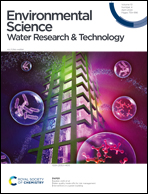Biological contributions to biological ion exchange†
Abstract
Biological ion exchange (BIEX) drinking water filters have been shown in lab- and pilot-scale systems to exhibit 40–60% removal of dissolved organic carbon (DOC) with minimal maintenance or operational needs. Three mechanisms are understood to contribute to DOC removal in BIEX filters: primary IEX (chloride-based DOC removal), secondary IEX (sulphate-based) and biodegradation. However, there is limited understanding of the biotic contributions to BIEX. This study investigated the contributions of biodegradation by operating BIEX filters beyond secondary IEX exhaustion. ‘Exhausted’ BIEX filters performed similarly to biological activated carbon (BAC) with DOC removal around 5%, while BIEX filters during secondary IEX showed 41% removal using the same influent. Monthly 16S rRNA gene amplicon sequencing revealed differences in the taxonomic profiles of microbial communities between BIEX and BAC filters with the same influent water, despite similarities in biological contributions to treatment performance. BIEX filters contained Janthinobacterium, Bacillariophyta, Flavobacterium, Mycobacterium and Nitrospira species, while BAC had Staphylococcus, Chryseobacterium, Bacteroides, Aquicella and Chryseolinea. Variances were attributed to contrasting filter media surface characteristics encouraging different microbial populations. BIEX filters reduced effluent cellular ATP by around 70%, leading to a hypothesized benefit of waterborne microbe removal. Based on these findings, we recommend that BIEX drinking water filters be optimized for DOC removal through secondary IEX and not necessarily for biological performance.



 Please wait while we load your content...
Please wait while we load your content...